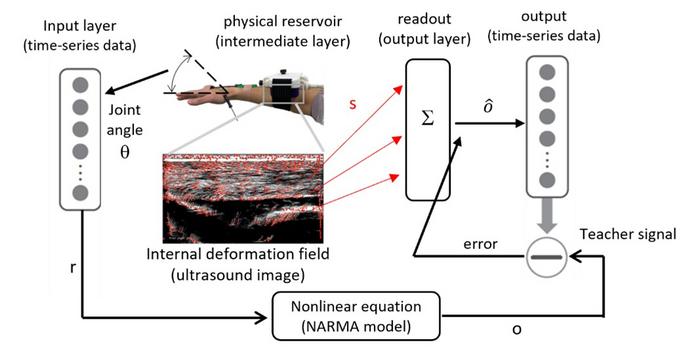In a realm where digital computation dominates, a groundbreaking exploration is emerging from Osaka, Japan, challenging our understanding of both computing and the capabilities of biological systems. Yo Kobayashi, a researcher from the Graduate School of Engineering Science at The University of Osaka, has unveiled a revolutionary concept: the potential of human soft tissue to serve as a computational medium. This innovative approach posits that human biology itself could be leveraged not just for data input but for complex processing tasks akin to traditional computing systems.
Kobayashi’s research, published in the prestigious journal IEEE Access, underscores a pivotal shift in the paradigm of computational methodologies. Traditionally, computers rely on microchips and circuit boards to process information. However, what if our organic structures could perform similar functions without the conventional hardware? Kobayashi’s study provides the foundation for this possibility, drawing upon the principles of reservoir computing—a computational framework that excels in handling complex data through dynamic systems.
Reservoir computing operates on the premise of harnessing chaotic, nonlinear systems to create a “reservoir” of information. This reservoir can encode complex patterns, which are then decoded into meaningful outcomes through neural networks. Until Kobayashi’s work, such reservoirs largely comprised mechanical constructs like fluid tanks or electrical circuits. His research is a pioneering exploration into the use of human tissues as a living reservoir, integrating biology with computation.
To substantiate his hypothesis, Kobayashi conducted an experimental study wherein volunteers provided biomechanical data by flexing their wrists at various angles. Real-time ultrasound imaging captured the resultant deformation of the muscle tissues, generating a unique dataset that served as the basis for his biophysical reservoir. This approach not only diversifies the types of computational mediums but also taps into the inherent complexity and adaptability of living organisms.
One of the remarkable findings of Kobayashi’s experiments was the quality of computation achievable with human soft tissue. Benchmark tests, comparing the biophysical reservoir with standard linear regression techniques, revealed a striking improvement in accuracy. In scenarios where nonlinear equations were solved, the biologically based model outperformed traditional computational methods by a significant margin. This revelation is not just an academic triumph; it hints at practical applications that could redefine our interaction with technology.
As consumer technology rapidly advances, the integration of biological computation represents new frontiers in areas like healthcare and wearable devices. Kobayashi envisions a future where our own flesh and muscle act as computational resources, particularly through wearable technology that intelligently utilizes soft tissue for real-time processing. Such a concept aligns seamlessly with the growing trend of biointegration in technology, facilitating an unprecedented synergy between human functionality and computational efficiency.
The implications of this research stretch far beyond mere theoretical exploration. The ability to use human tissues as computational mediums could revolutionize fields such as computational biology, where understanding complex biological processes through advanced modeling is critical. Moreover, as the demand for more intuitive and personalized technology increases, this research is at the forefront of developing solutions that resonate more closely with human biology.
Looking ahead, Kobayashi’s ambitious agenda includes scaling the model to tackle even more intricate computations. He aims to explore other biomaterials that could serve as suitable reservoirs, broadening the scope of this innovative approach. Intriguingly, the combination of machine learning with organic computation suggests that future technologies could employ a hybrid model, harnessing the best of computational efficiency alongside the complex adaptabilities of organic systems.
This pioneering research invites us to reimagine the boundaries between biology and technology. The burgeoning field of biocomputing poses profound questions regarding the nature of intelligence and information processing. As we advance into an era where biological systems can perform computational tasks, it challenges us to rethink not just our technological architectures but also our definitions of computation itself.
The potential for a new era of organic computing is not confined to theoretical discussions in academic circles. As studies like Kobayashi’s gain traction, they inspire a wave of innovation that could permeate various industries. Whether in medicine, robotics, or even artificial intelligence, the ability to draw computational power from living tissues presents manifold opportunities to enhance human capabilities and redefine outputs.
With the groundwork laid, the confluence of biology and technology beckons researchers, engineers, and innovators. We stand on the cusp of a revolution, one that may irrevocably alter our relationship with machines, pushing the boundaries of what we once thought possible in data computation. The convergence of soft tissue and digital processing not only advances scientific knowledge but also presents a tantalizing glimpse into the collaborative future of humanity and machines.
This groundbreaking study not only illuminates the power of living systems as computational resources but also serves as a call to embrace the potential of interdisciplinary research. As we forge ahead into this new frontier, the integration of biological intelligence into technological frameworks could lead to solutions that augment human life in ways previously deemed unimaginable. Kobayashi’s work is a beacon illuminating the pathway to not only understanding but utilizing the very essence of what it means to compute.
In conclusion, as we reflect on the possibilities presented by this novel research, it becomes clear that the future of computation may very well reside within ourselves. With further exploration and technological advancement, the day may come when we interact with our surroundings through organic computation, harnessing the innate capabilities of our biological structures to engage with the world in radically transformative ways.
Subject of Research: People
Article Title: Information processing via human soft tissue: Soft tissue reservoir computing
News Publication Date: 20-Mar-2025
Web References: http://dx.doi.org/10.1109/ACCESS.2024.0429000
References: Kobayashi, Y. (2025). Information processing via human soft tissue: Soft tissue reservoir computing. IEEE Access. DOI: 10.1109/ACCESS.2024.0429000
Image Credits: 2025. Yo Kobayashi. Information processing via human soft tissue: Soft tissue reservoir computing. IEEE Access.
Keywords: Biocomputing, Reservoir Computing, Human Soft Tissue, Computational Frameworks, Wearable Technology, Nonlinear Equations, Biomedical Engineering, Interdisciplinary Research




